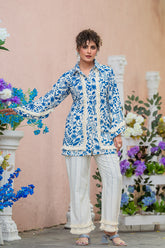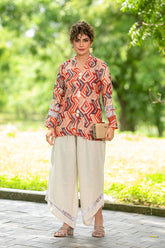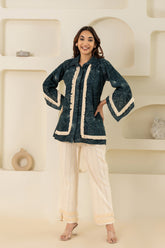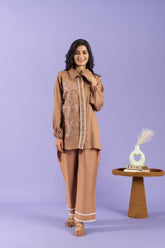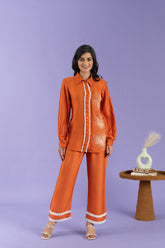The Psychology of Color in Fashion: What Your Outfit Says About You

Imagine walking into a room and making a statement without uttering a single word this is the silent power of the colors you wear. From the bold confidence of red to the calming trust of blue, every shade in your wardrobe holds the potential to influence how others see you and even how you feel about yourself. Whether you're dressing to impress at a job interview, spark connection on a date, or simply express your unique personality, the colors you choose are far more than just fashion—they're a language of their own. Curious about what your outfit says about you? Let’s dive into the fascinating world where fashion meets the psychology of color and unlock the secrets hidden in your wardrobe!
The Role of Color Psychology in Fashion
Color psychology studies how colors influence human emotions, behaviors, and perceptions. In fashion, this concept takes on a transformative role by enabling individuals to express their identity while shaping how they are perceived by others. From ancient civilizations using colors for symbolic purposes to modern brands leveraging them for marketing, the impact of color is undeniable.
Historical Significance
In ancient cultures, colors carried deep symbolic meanings. For example:
-
Red was associated with power and vitality in ancient Rome.
-
White purity in many religious rituals.
-
Gold represented wealth and divinity across various civilizations.
Today, these associations persist but have evolved to include personal expression and branding. Iconic fashion brands like Christian Louboutin (red soles) or Tiffany & Co. (signature blue) use specific colors to create strong visual identities that resonate with their audience.
How Colors Shape Perception and Mood
Colors in fashion are not just about aesthetics—they carry emotional and psychological weight. Here’s how they influence perception and mood:
1. Emotional Expression
Colors evoke specific emotions:
-
Bright tones like yellow or orange uplift moods by radiating energy and positivity.
-
Cool shades like blue or green calm the mind, creating a sense of tranquility.
-
Neutral colors like black or white convey sophistication, simplicity, or authority.
For instance, wearing red can make you feel bold and confident, while pastel hues can evoke feelings of softness and approachability.
2. Cultural and Social Influences
Cultural contexts often shape how colors are interpreted:
-
In Western cultures, white symbolizes purity (e.g., bridal gowns), while in some Eastern traditions, it represents mourning.
-
Red is considered lucky in China but can signify danger or passion in other contexts.
-
Understanding these nuances can help you choose colors that align with your audience's cultural expectations.
3. Personal Identity
Your choice of colors often reflects your personality traits:
-
Vibrant hues may indicate confidence and extroversion.
-
Subdued tones suggest introspection or elegance.
-
For example, someone who frequently wears purple might be seen as creative or luxurious, while those who favor black may project authority and sophistication.

The Hidden Messages Behind Popular Colors
Let’s dive deeper into what different colors might say about you when incorporated into your wardrobe:
Warm Colors: Energy and Passion
-
Red: Represents boldness, passion, and power. Wearing red makes a statement—it’s ideal for commanding attention at events or exuding confidence during presentations.
-
Orange: Symbolizes creativity and enthusiasm. It’s perfect for showcasing a fun-loving personality or adding warmth to casual outfits.
-
Yellow: Evokes optimism and cheerfulness. A sunny yellow piece can brighten your mood and spread positivity to those around you.
Cool Colors: Calmness and Trust
-
Blue: Associated with dependability and serenity. It’s an excellent choice for professional settings where you want to appear approachable yet authoritative.
-
Green: Reflects balance and growth. Often linked to eco-consciousness or a peaceful demeanor, green is soothing to both the wearer and observer.
-
Purple: Represents creativity and luxury. It’s favored by those who value imagination or want to project an air of exclusivity.
Neutral Colors: Elegance and Simplicity
-
Black: Conveys authority, sophistication, and mystery. A staple for formal occasions, black is versatile yet powerful.
-
White: Symbolizes purity and clarity. It’s ideal for projecting simplicity or starting fresh.
-
Gray: Suggests maturity and neutrality. It’s a go-to for understated elegance in professional settings.
Why Color Choices Matter in Fashion
Fashion isn’t just about looking good—it’s about feeling good too. Here’s why your color choices matter:
1. Boosting Confidence
Wearing colors that resonate with your mood can enhance self-esteem:
-
Red empowers during high-stakes situations like interviews or speeches.
-
Green promotes calmness under pressure.
2. Creating First Impressions
Studies suggest that up to 90% of first impressions are based on color alone. Choosing the right hue can help you make a lasting impact:
-
Bright tones work well for casual outings where you want to appear approachable.
-
Dark neutrals exude professionalism during formal events.
3. Aligning With Occasions
Different events call for different vibes:
-
Pastels suit daytime gatherings like brunches or garden parties.
-
Bold hues like red or orange are great for evening events where you want to stand out.
4. Enhancing Personal Branding
Color is a key element in building personal branding, and its strategic use can significantly shape how others perceive you. Just as brands like Coca-Cola (red for energy and positivity) or Tiffany & Co. (blue for elegance and trust) use signature colors to stand out, individuals can leverage color psychology to reinforce their identity and values.
Why It Matters
Colors evoke emotions and create lasting associations:
-
Bold colors like red or yellow exude confidence and energy, making them ideal for standing out.
-
Cool tones like blue or green convey trust and calmness, perfect for building reliability.
-
Neutrals like black or gray communicate sophistication and authority, often favored in professional settings.
Brands such as Nickelodeon successfully use orange to evoke creativity and playfulness, while IBM’s blue reflects dependability and security. These examples highlight how consistent color choices can create strong emotional connections with audiences.

How to Use Color Psychology in Your Wardrobe
Here are actionable tips to incorporate color psychology into your everyday style:
-
Start Small
-
If bold colors intimidate you, begin with accessories like scarves, shoes, or handbags in vibrant hues.
-
Dress for Your Mood
-
Feeling low? Bright yellows or oranges can lift your spirits.
-
Need focus? Blues and greens promote calm concentration.
-
Experiment With Combinations
-
Mix complementary colors (e.g., blue with orange) for balance.
-
Try analogous tones (e.g., red with pink) for harmony.
-
Match Colors to Occasions
-
Wear black for authority at work meetings but switch to pastels for casual brunches with friends.
-
Reflect Your Personality
-
Choose shades that align with your character—whether it’s fiery reds for boldness or serene blues for calmness.
Conclusion
Fashion is more than just clothing; it’s an art form that allows us to communicate without words. By understanding the psychology of color, you can curate a wardrobe that not only looks stunning but also aligns with your personality and goals.
So next time you’re picking out an outfit, think beyond trends—consider what story your colors.
Let your wardrobe become an extension of who you truly are—and don’t hesitate to experiment! The right colors might just transform not only how others see you but also how you see yourself. Ready to transform your style using the power of color psychology? Start experimenting today! Share your favorite outfit combinations—what do they say about you.

